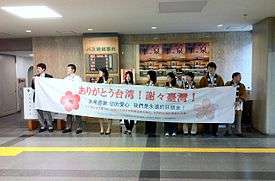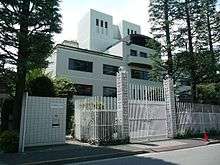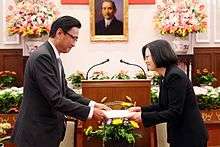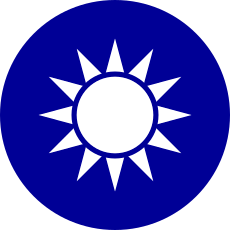Japan–Taiwan relations
 | |
Japan |
Taiwan |
|---|---|
| Diplomatic Mission | |
| Japan–Taiwan Exchange Association | Taipei Economic and Cultural Representative Office in Japan |

After the Japan–PRC Joint Communiqué in 1972, Japan no longer recognizes the Republic of China as the sole official government of China. However, Japan has maintained non-governmental, working-level relations with ROC.[1]
History
Early
In the 1600s, there was considerable trade between Japan and Taiwan. The Dutch colonized Taiwan as a base for trade with Japan in 1624.
Kingdom of Tungning & Taiwan under Qing rule
During the Kingdom of Tungning era (1662–83), Japan bought deerskin, sugar and silk from Taiwan and sold Precious metal, porcelain, armors and cotton cloth. Japanese money could be used in Taiwan during that period and Japanese merchants were permitted to live in Keelung.[2][3][4]
In 1874, Japanese troops invaded southern Taiwan to attack aboriginal tribes, in revenge for the killing of 54 Ryukyuan sailors in 1871.
Taiwan under Japanese rule
Japan's victory over Qing dynasty in the First Sino-Japanese War resulted in the 1895 Treaty of Shimonoseki, in which Taiwan was ceded to Japan. Taiwan was then ruled by the Empire of Japan until 1945. After Japan's surrender at the end of World War II, Taiwan was occupied by an exile government, the Republic of China.
ROC in Taiwan
Establishment, early 1950s

After the war between China and Japan, during the occupation of Japan, Prime Minister Shigeru Yoshida (officially the last prime minister under the royal decree by the Japanese emperor), intended to approach the newly established People's Republic of China economically and diplomatically. However, the US rectified this initiative and threatened to boycott the 1951 Treaty of San Francisco if Japan did not to engage with KMT-led Nationalist China (now Taiwan) and the later formation of the Treaty of Taipei (a parallel treaty to the Treaty of San Francisco between Japan and the two Chinas that were excluded). The US required Japan to accept diplomatic relations with the KMT-led Nationalist China otherwise sovereignty to the country would not be restored, effectively maintaining war with the US and keep it under US military occupation.
By taking everything into consideration, in the midst of the US creating its containment policy in Asia, Prime Minister Yoshida shifted his stance with regard to the US administration (to then-US Secretary of State John Foster Dulles), as detailed in the Yoshida Letter,[5] to negotiate a peace treaty with Taipei instead. Also as a result of ratification of the Treaty of San Francisco by the US Congress and Senate, he officially ended Japan's status as an imperial power, officially relinquishing of the island of Taiwan and Pescadores. These actions were drafted into Article 9 of the new liberal democratic Japanese Constitution which dismantled the country's military capabilities to declare war on another country with the reservation of self-defense limitations and later stipulated the Security Treaty Between the United States and Japan, which was also passed and enacted by the majority members of the new Japanese Diet with subsequent security treaties in the post-war era.
With the eruption of Korean War and US and UN intervention into that war, diplomatic relations between the governments of Japan and KMT-led Nationalist China were established following the termination of US occupation of Japan in 1952. Japan led the logistics and artillery production/manufacturing to support the US in the Korean War, which acted as the major stimulus for the revival of the its economy, especially in heavy and light industry, soon evident in the Japanese post-war economic miracle. On April 28, 1952, a formal peace treaty was concluded between the Japan and what is now Taiwan, as the former refrained from recognizing the People's Republic of China at that time. In Article 10 of the Treaty of Taipei (Sino-Japanese Peace Treaty) that retrospects:
for the purposes of the present Treaty, nationals of the Republic of China shall be deemed to include all the inhabitants and former inhabitants of (Taiwan (Formosa)) and Penghu (the Pescadores) and their descendants who are of Chinese nationality in accordance with the laws and regulations which have been or may hereafter be enforced by the Republic of China in Taiwan (Formosa) and Penghu (the Pescadores); and juridical persons of the Republic of China shall be deemed to include all those registered under the laws and regulations which have been or may hereafter be enforced by the Republic of China in Taiwan (Formosa) and Penghu (the Pescadores).
Bilaterally, Japan had, and still has from members of the Japan Business Federation, strong trading ties with Taipei. Japan played a key financial role of governmental loans to the ROC government to help with the burgeoning country's economic development on various levels before the Nixon Shock[6][7][8] and the severing of ties between the two governments.
In 1958, the Sino-Ryukyuan Economic and Cultural Association was established at Naha, Okinawa which was the strategic headquarters of the US Armed Forces in the region. In 1972, Okinawa was returned to Japan by the U.S. but the association remained as an institution to foster relations, dialogue and academic exchange between Japan, Okinawa and Taiwan.
Joint Communiqué, 1972
Regarding the One-China policy, Japan had been an earnest ally to Taiwan, however, global politics pushed Japan to overturn its position. As the attempt to belligerently recover mainland China failed and faded and the Taipei-based government was expelled, voted out of UN in a General Assembly vote, by majority UN member states via United Nations General Assembly Resolution 2758, soon after US President Richard Nixon's visit to People's Republic of China in 1972[9] and the release of the "Joint Communiqué of the United States of America and the People's Republic of China," Japan's Liberal Democratic Party-majority government led by Kakuei Tanaka decided to establish formal diplomatic relations with the PRC. Before this, Japan had already had robust non-governmental trading relations with the PRC without formal diplomatic recognition.
As a pre-condition for building ties with the PRC, Japan abrogated and made defunct the Treaty of Taipei in relation to then non-recognized Taiwan polity. According to the "1972 Japan–China Joint Communiqué", the Japanese government fully understood and respected the position of the government of the People's Republic of China (PRC) that Taiwan was an inalienable territory of the PRC, and it firmly maintained its stand under Article 8 of the Potsdam Proclamation,[10] which stated "The terms of the Cairo Declaration shall be carried out and Japanese sovereignty shall be limited to the islands of Honshū, Hokkaidō, Kyūshū, Shikoku and such minor islands as we determine."
Statements and principles set in the Joint Communiqué of 1972 were written in the Treaty of Peace and Friendship between Japan and the People's Republic of China in 1978. Japan and the PRC agreed to continue abiding by the treaty when former Prime Minister of Japan Shinzo Abe visited Beijing on 8 October 2006.
Japan–China Joint Declaration, 1998
In 1998, Japan and the PRC signed the Japan–China Joint Declaration on Building a Partnership of Friendship and Cooperation for Peace and Development that stated that Japan was to continue to side with the PRC on the One-China policy, that it "continues to maintain its stand on the Taiwan issue as set forth in the Joint Communiqué of the Government of Japan and the Government of the People's Republic of China and reiterates its understanding that there is only one China." Japan reiterated it will maintain its exchanges with Taiwan, however in a private and regional forms.
Recent initiatives, 2005–present

Japan grants Taiwanese passport holders visa exemption for 90 days.[11] This rule became effective on 20 September 2005, in line with a move aimed at attracting more tourists to Japan. Jiro Akama, Deputy Minister of Internal Affairs and Communication was the highest ranking cabinet official since 1972 to visit Taiwan on March 25 to celebrate the tourist event and promote Japanese regional revitalization,[12] amid with the ban of Japanese agricultural exports to Taiwanese public.[13]
In the press conference on 31 January 2006, Deputy Press Secretary Tomohiko Taniguchi announced that, in a speech a year earlier, Minister of Foreign Affairs Tarō Asō had expressed concern regarding peace and stability across the Taiwan Strait on the basis of the 1972 Japan–PRC Joint Communiqué. The announcement reiterated the Japanese government's position "that we do not take a policy of two Chinas or one China and one Taiwan."
Fishery demarcation, 1996–present
Japan insists, on the basis of United Nations Convention on the Law of the Sea,[14] that Japan is privileged on the fishery demarcation to the southern tip of its surrounding territorial waters, whereas Taiwan asserts that it participates as a fishing entity in the Regional Fisheries Management Organisation on the basis of United Nations Fish Stocks Agreement, such as the admission of IATTC,[15] that also applies on the issue of fishery demarcation with Japan.[16][17] There were sixteen fishery conferences in total between the two stakeholders, Interchange Association, Japan[18] and Association of East Asian Relations of Taiwan,[19][20] on fishery demarcation from 1996 to 2009, and the dispute of exclusive economic zone between Japan[21][22] and Taiwan [23] is still not resolved pertaining to future negotiations between the two sides.[24][25][26][27][28] Despite this dispute, the two sides reached a fisheries resource management agreement on April 10, 2013.[29][30][31][32]
On the official international tie between the two governments, think tanks from Taiwan is a member of Asian Development Bank Institute, which is located in Kasumigaseki Building in Chiyoda, Tokyo.[33][34]
Guang Hua Student Dormitory lawsuit
After 40 years of strenuous effort on the trial by the ROC government on the Public international law of Kyoto-based ROC government property of Guang Hua Student Dormitory against the international legal claim by the PRC government, according to Article 81 [35] of the Japanese Constitution, the Supreme Court of Japan judged in 2007 that the property belongs to the PRC government on the basis that Japan recognizes PRC instead of ROC (Taiwan) after 1972.[36] ROC is considered as a Rump State after 1949. ROC is a member of Property Rights Alliance.[37]
Education
Overseas Chinese schools, like those in many other countries, are administratively and financially supported by the Taiwan (R.O.C.) government's Overseas Community Affairs Council. In Japan, before 2003,[38][39][40] Overseas Chinese School graduates did not qualify for Japanese college entrance exam. The future task lies on the legalization of the Overseas Chinese School by the Japanese Government and international educational agency accreditation (such as International Baccalaureate, Cambridge International Examinations and Advanced Placement accreditation [41]), or similar international recognition of Taiwan's education, for qualifying the legal international status of Overseas Chinese School in Japan. Those supported by the ROC are:
Japan operates three nihonjin gakkō (overseas Japanese schools operated by a Japanese association) on the island of Taiwan:
Culture
On 21 April 2010, Taiwan established the Taipei Cultural Center in Tokyo, Japan and was subsequently renamed Taiwan Cultural Center. On 27 November 2017, Japan established the Japanese Cultural Center in Taipei, Taiwan.
See also
References
- ↑ http://www.mofa.go.jp/region/asia-paci/taiwan/pdfs/japan-taiwan_relations.pdf
- ↑ 《台灣史101問》,頁109
- ↑ 《臺灣政治史》,頁62-63
- ↑ 鄭氏時期總論
- ↑ Cohen, J p. 50-56, Iriye, A. Cohen, W p. 21-34, Schonberger, H p. 275-285
- ↑ "international payment and exchange - economics". Encyclopædia Britannica. Retrieved 3 April 2016.
- ↑ "About the IMF: History: The end of the Bretton Woods System (1972–81)". Retrieved 3 April 2016.
- ↑ ERIC RAUCHWAY (13 November 2015). "Bretton Woods System". Retrieved 3 April 2016.
- ↑ "Nixon announces visit to communist China". HISTORY.com. Retrieved 3 April 2016.
- ↑ Joint Communique of the Government of Japan and the Government of the People's Republic of China "3. The Government of the People's Republic of China reiterates that Taiwan is an inalienable part of the territory of the People's Republic of China. The Government of Japan fully understands and respects this stand of the Government of the People's Republic of China, and it firmly maintains its stand under Article 8 of the Postsdam Proclamation."
- ↑ As the residents in Taiwan were stipulated by a government ordinance as aliens defined in the Law on Special Cases of Landing Application by Aliens who hold passports stipulated in Article 2-5-2 of the Immigration Control and Refugee Recognition Act
- ↑ http://asia.nikkei.com/Politics-Economy/International-Relations/Japan-vice-minister-officially-visits-Taiwan
- ↑ http://m.ltn.com.tw/news/focus/breakingnews/2016507
- ↑ Unclos+Annexes+Res.+Agreement
- ↑ "Inter-American Tropical Tuna Commission" (PDF). Iattc.org. Retrieved 2013-10-08.
- ↑ "Overview - Convention & Related Agreements". Retrieved 3 April 2016.
- ↑ "中華民國外交部 - 全球資訊網 Ministry of Foreign Affairs, Republic of China (Taiwan)". 中華民國外交部 - 全球資訊網 Ministry of Foreign Affairs, Republic of China (Taiwan). Retrieved 3 April 2016.
- ↑ "交流協會 臺北事務所 (中文)". Retrieved 3 April 2016.
- ↑ "中華民國外交部 - 全球資訊網 Ministry of Foreign Affairs, Republic of China (Taiwan)". 中華民國外交部 - 全球資訊網 Ministry of Foreign Affairs, Republic of China (Taiwan). Retrieved 3 April 2016.
- ↑ "百年傳承 走出活路─中華民國外交史料特展_走出活路". Retrieved 3 April 2016.
- ↑ "Sea Around Us - Fisheries, Ecosystems and Biodiversity". Retrieved 3 April 2016.
- ↑ "Sea Around Us - Fisheries, Ecosystems and Biodiversity". Retrieved 3 April 2016.
- ↑ "Sea Around Us - Fisheries, Ecosystems and Biodiversity". Retrieved 3 April 2016.
- ↑ "Japan fishing talks still on hold". Retrieved 3 April 2016.
- ↑ "BBC NEWS - Asia-Pacific - Taiwan ship joins island dispute". Retrieved 3 April 2016.
- ↑ "404". Retrieved 3 April 2016.
- ↑ Taiwan activists enter Japan's contiguous zone : National : DAILY YOMIURI ONLINE (The Daily Yomiuri)
- ↑ "Notice". Archived from the original on 4 March 2016. Retrieved 3 April 2016.
- ↑ Global Legal Monitor: Japan / Taiwan: Landmark Fishing Agreement | Global Legal Monitor | Law Library of Congress | Library of Congress. Loc.gov. Retrieved on 2013-08-16.
- ↑ Taiwan and Japan reach fisheries agreement, jointly forge lasting peace in East China Sea. English.president.gov.tw (2011-03-11). Retrieved on 2013-08-16.
- ↑ Japan to let Taiwanese fish near the Senkakus. The Japan Times. Retrieved on 2013-08-16.
- ↑ Japan, Taiwan agree on fishing rights around Senkakus - AJW by The Asahi Shimbun. Ajw.asahi.com. Retrieved on 2013-08-16.
- ↑ http://www.adbi.org/book/2005/12/01/1568.think.tanks.directory/taipeichina/
- ↑ "霞が関ビルディング|フロアガイド". Retrieved 3 April 2016.
- ↑ http://japan.kantei.go.jp/constitution_and_government_of_japan/constitution_e.html
- ↑ "Beijing wins in Japan dorm row". Taipei Times. AFP. 28 March 2007. Retrieved 14 February 2017.
- ↑ "Archived copy". Archived from the original on 2016-12-27. Retrieved 2016-12-22.
- ↑ "多元文化社会与教育——日本华侨学校的困境与发展方向". Retrieved 3 April 2016.
- ↑ http://moodle.ncnu.edu.tw/pluginfile.php/522594/mod_resource/content/1/2013.04.15%E8%A3%98%E6%9B%89%E8%98%AD.pdf
- ↑ https://dspace.wul.waseda.ac.jp/dspace/bitstream/2065/32747/1/KyoyoShogakuKenkyu_118_Zhang.pdf
- ↑ "NCEE » The College Board – Advanced Placement Program". Retrieved 3 April 2016.
Further reading
- Cohen, J 1973 The Dynamics of China's Foreign Relations, p. 50-56, Harvard University Press, Cambridge
- Iriye, A. Cohen, W 1989 The United States and Japan in the Postwar World, p. 21-34, The University Press of Kentucky, Lexington
- Hu, S. ‘Japan and the Cross-Taiwan Strait Conflict,’ Journal of Chinese Political Science, Vol. 11, No. 2 (Fall 2006): pp. 83–103.
- Schonberger, H 1989 Aftermath of War - Americans and the Remaking of Japan, 1945–1952, p. 275-285, The Kent State University Press, Kent
- Wilkins, Thomas, ‘Taiwan-Japan Relations in an Era of Uncertainty’ Asia Policy, Vol. 13, (January 2012), pp. 113–132.
External links
| Wikimedia Commons has media related to Relations of Japan and Taiwan. |
_Taipei_Office_20100101a.jpg)

